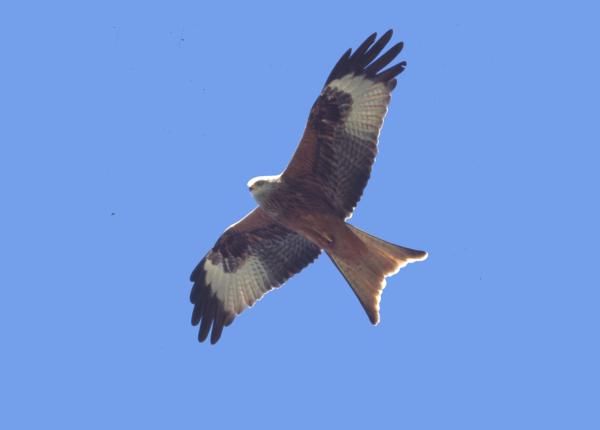Did You Know?
- Several European countries have launched conservation programs for the Red Kite, many of which include captive breeding and release efforts.
- Though it is common for people to provide nectar, seeds and fruits for backyard birds, some people in the U.K. are placing meat (mostly chicken) in their backyards, to help entice Red Kites to visit!
- There are two recognized subspecies of Red Kite. Sadly, one of these may be extinct.
How The Peregrine Fund is Helping
Though The Peregrine Fund doesn't work directly with Red Kites, our efforts in scientific research, habitat conservation, education, and community development help conserve raptors on a global scale. We also supply literature to researchers from our avian research library, which helps scientists around the world gather and share important information on raptor conservation.
Where They Live
The Red Kite is found throughout much of western Europe and northern Africa. It breeds in or migrates to a number of different countries including Great Britain, Spain, Portugal, Denmark, Germany, France, Poland, Serbia, Morocco, Tunisia, Iran, Turkey and the Ukraine, to name just a few. It is considered extinct on the Canary Islands and Cape Verde.
Throughout much of the Red Kite's range, it inhabits a mosaic of different habitats including mature deciduous and mixed forests, forest edges, clearings, meadows, cultivated fields, pastures in both lowlands and highlands, flooded and riverine forests, Mediterranean bush, oaks, pinewoods, farmlands, scrub habitat, wetlands, and olive tree plantations.
What They Do
The Red Kite is a stunning raptor. Based on its name, one might guess that this kite has at least some red in its plumage. And, in fact, they do! Adult Red Kites have rusty-red tails that really stand out in flight. It has a pale eye and an overall grey head and neck, which are streaked with thin dark lines. It has a yellow cere and black beak, and its back, wings, and breast are a mosaic of reds, browns, and creams. In flight, it has distinctive white patches on the underwings and, perhaps it has a deeply forked-tail, which is visible both in flight and when it is perched..All in all, the Red Kite is one of the most stunning kites around.
Depending on where they live, some Red Kite populations are mostly stationary - meaning they will remain on their territory all year round. While others will migrate south when winter sets in. The Red Kite has been described as elegant, regal, and just plain lovely. It can often be seen soaring with its long wings spread at an upward angle - known as dihedral.
Why They Need our Help
The Red Kite is listed as a species of Least Concern. Sadly, the species is facing many threats such as secondary poisoning from pesticides (which occurs when Red Kites feed on prey that have ingested poison) or deliberate poisoning - this is when people lace dead animals with poison, so the kites ingest it directly when they consume the meat. Other threats include human persecution and loss of habitat. Because of these threats, the population is experiencing a decline in much of its range.
What They Eat
The Red Kite has a long list of prey items on its menu. It will hunt mammals such as rabbits, mice, shrews and voles. It will also take small birds and insects - including grasshoppers, beetles, ants, moths and craneflies. It is also known to feed on earthworms, which make up a good portion of its diet.
Like the Yellow-headed Caracara, the Red Kite is also a well-known carrion feeder. Carrion are animals that are already dead - having died from another cause such as disease, being hit by a car or electrocuted, or taken down by another predator.
In some cases, the Red Kite has even been documented to feed on human refuse (which is a fancy word for poop).
Nest, Eggs and Young
The Red Kite builds a good-sized nest out of sticks and twigs. As you might imagine, a stick nest could be quite an uncomfortable place to lie down in for long periods of time - such as when the female is incubating or when the chicks are very young. To help make the nest more comfortable, the Red Kite will line the nest with soft materials such as leaves and sheep wool. This is a common practice among many raptor species.
The Red Kite usually constructs its nest in a deciduous or coniferous tree. When the time is right, the female will lay between 1-4 eggs. Once the eggs are laid, the female will take on most of the incubation duties. She will care for her eggs, sitting on them, turning them, and making sure they are kept at just the right temperature, until her nestlings hatch after around 30 days.
The young fledge, or fly for the first time, at approximately 55 days old. However, just because they can fly doesn't mean they still don't need their parents. The young will remain dependent on the adults - learning to hunt and how to avoid danger - for another 3 weeks or so.
Red Kite and The World Center for Birds of Prey
The World Center for Birds of Prey offers fun ways to learn about birds of prey. The visitor center has interactive displays, tours, interesting videos and a children's room with activities from coloring sheets to quizzes to costumes and a touch table for the curious mind. We also have several different birds of prey on display year-around. Knowledgeable staff and volunteers are on hand to answer any questions you may have about Red Kites or any other birds of prey.
Research Resources
David, T. S., J. Orta, D. A. Christie, and E. F. J. Garcia (2021). Red Kite (Milvus milvus), version 1.1. In Birds of the World (S. M. Billerman, Editor). Cornell Lab of Ornithology, Ithaca, NY, USA. https://doi.org/10.2173/bow.redkit1.01.1
Red Kite in Global Raptor Information Network
https://www.rspb.org.uk/birds-and-wildlife/wildlife-guides/bird-a-z/red-kite/










